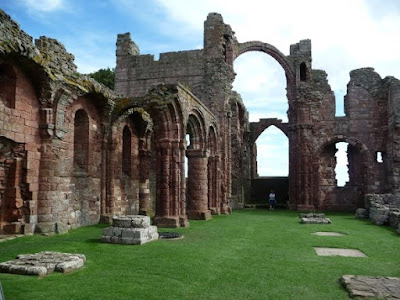Just off the Northumberland coast, south of Scotland, sits The Holy Island, Lindisfarne, where St. Cuthbert was a hermit and headed a priory (sort of a sub-abbey); he was later bishop in Durham (or York?). His missionary work converted most of the north of England.
The Holy Island (that's really what it is called) is particularly cool in that to get to it, other than via boat, you have to wait for low tide. Then you can drive or walk. The road across is actually paved. But you have to plan your crossing, and return, in accordance with the tide tables.
Watching the tide come and go is always interesting, to me anyway. Other than driving a tidal causeway, and walking part of it, other "firsts" today including sampling mead and having a small dish of cockles with lunch. But enough of England, for now. Tomorrow we're in Scotland.
The Holy Island (that's really what it is called) is particularly cool in that to get to it, other than via boat, you have to wait for low tide. Then you can drive or walk. The road across is actually paved. But you have to plan your crossing, and return, in accordance with the tide tables.
Watching the tide come and go is always interesting, to me anyway. Other than driving a tidal causeway, and walking part of it, other "firsts" today including sampling mead and having a small dish of cockles with lunch. But enough of England, for now. Tomorrow we're in Scotland.
 |
Another half hour and it is driveable |
 |
You have been warned |
 |
Priory ruins; originally founded by Cuthbert and associates in 7th century, destroyed by Vikings, reestablished in 11th or 12th century; Dissolved by Henry VIII in 1539; etc. Now a national heritage site. |
 |
More priory ruins |
 |
Statue of Cuthbert |
 |
Castle (14th century I think) from priory |
 |
View of village and priory from castle |
 |
| Bamburgh Castle, several miles further down the coast |
Just off the Northumberland coast, south of Scotland, sits The Holy Island, Lindisfarne, where St. Cuthbert was a hermit and headed a priory (sort of a sub-abbey); he was later bishop in Durham (or York?). His missionary work converted most of the north of England.
The Holy Island (that's really what it is called) is particularly cool in that to get to it, other than via boat, you have to wait for low tide. Then you can drive or walk. The road across is actually paved. But you have to plan your crossing, and return, in accordance with the tide tables.
Watching the tide come and go is always interesting, to me anyway. Other than driving a tidal causeway, and walking part of it, other "firsts" today including sampling mead and having a small dish of cockles with lunch. But enough of England, for now. Tomorrow we're in Scotland.
No comments:
Post a Comment